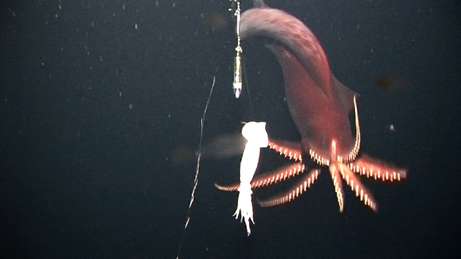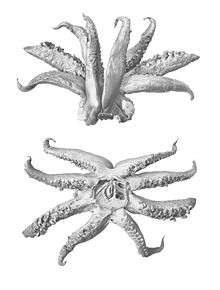Taningia danae
| Dana octopus squid | |
|---|---|
 | |
| Scientific classification | |
| Kingdom: | Animalia |
| Phylum: | Mollusca |
| Class: | Cephalopoda |
| Order: | Teuthida |
| Family: | Octopoteuthidae |
| Genus: | Taningia |
| Species: | T. danae |
| Binomial name | |
| Taningia danae Joubin, 1931 | |
| Synonyms | |
| |
Taningia danae, the Dana octopus squid, is a species of squid in the family Octopoteuthidae. It is one of the largest known squid species, reaching a mantle length of 1.7 m (5.6 ft)[1] and total length of 2.3 m (7.5 ft).[2] The largest known specimen, a mature female, weighed 161.4 kilograms (356 lb).[3][nb a]
Taningia danae is named after Danish fisheries biologist Åge Vedel Tåning (1890–1958), who often traveled on the research vessel Dana.
Hunting behaviour and bioluminescence
In 2005, a Japanese research team headed by Tsunemi Kubodera managed to film T. danae in its natural habitat for the first time. The video footage, shot in deep water off Chichi-jima in the northern Pacific Ocean, shows T. danae emitting blinding flashes of light from photophores on its arms as it attacks its prey. It is believed that this highly maneuverable squid uses the bright flashes to disorientate potential prey. These flashes may also serve to illuminate the prey to make for easier capture as well as a courtship and territorial display.[2]
As well as a predatorial characteristic, Dana bioluminescence has also been suggested to be a defense mechanism. Juveniles of this species have been observed moving rapidly in the direction of potential predators, as if hunting, to disorientate and startle the threat with a mock attack.[4]
In 2012, Taningia danae was filmed twice more during a search for the giant squid for the Discovery Channel Special, Monster Squid: The Giant Is Real.[5]


Remains of Dana octopus squid have, on occasion, been found washed ashore on beaches. In 2008, a mantle of T. danae was discovered by students in Bermuda's Grape Bay, while tentacle remnants were found further along the shore.[6] In early 2013, a 54 kg (119 lb) specimen with a length (excluding arms) of 103 cm (3.38 ft) was trawled at a depth of 240 m (790 ft) off the coast of Estaca de Bares, Galicia, Spain. It was loaned to the Spanish Institute of Oceanography.[7]
In popular culture
James Rollins' SIGMA Force Book 4: The Judas Strain (2007) provides detailed descriptions of sightings of schools of giant predatory squid in the waters off the island of Pusat[8] and graphic descriptions of collaboratortive squid attacks of several characters.[8][9] In the book's "Author's Note: Truth or Fiction: Fauna", Rollins shares: "As to our predatory squids, I based them on the species Taningia danae, which grow to six feet in length, hunt in packs, have brilliant light displays, and bear claws on their suckers. Definitely tough calamari."[10]
Notes
References
- ↑ Nesis, K.N. 1982. Abridged key to the cephalopod mollusks of the world's ocean. Light and Food Industry Publishing House, Moscow. 385+ii pp. (Russian) [Translated into English by B. S. Levitov, ed. by L. A. Burgess 1987. Cephalopods of the world. T.F.H. Publications, Neptune City, NJ. 351pp.]
- 1 2 Kubodera, T., Y. Koyama & K. Mori 2006. "Observations of wild hunting behaviour and bioluminescence of a large deep-sea, eight-armed squid, Taningia danae." (PDF). (295 KB) Proceedings of the Royal Society B: Biological Sciences 274(1613): 1029–1034. doi:10.1098/rspb.2006.0236
- 1 2 3 Roper, C.F.E. & P. Jereb 2010. Family Octopoteuthidae. In: P. Jereb & C.F.E. Roper (eds.) Cephalopods of the world. An annotated and illustrated catalogue of species known to date. Volume 2. Myopsid and Oegopsid Squids. FAO Species Catalogue for Fishery Purposes No. 4, Vol. 2. FAO, Rome. pp. 262–268.
- ↑ Young, R.E. & M. Vecchione 1999. Taningia danae Joubin, 1931. Version 1 January 1999. Tree of Life web project.
- ↑ Monster Squid: The Giant Is Real. Discovery Channel.
- ↑ Dale, A. 2008. "Monster from the Deep". Bermuda Royal Gazette, July 8, 2008.
- ↑ Aparece en Galicia un calamar gigante de 54 kilos y más de un metro de largo. Europa Press, 11 February 2013. (Spanish)
- 1 2 Rollins, James (2007). SIGMA Force Book 4: The Judas Strain. p. 66.
- ↑ Rollins, James (2007). SIGMA Force Book 4: The Judas Strain. p. 46.
- ↑ Rollins, James (2007). The Judas Strain. p. Author's Note, p. 2.
- ↑ Roper, C.F.E. & M. Vecchione 1993. "A geographic and taxonomic review of Taningia danae Joubin, 1931 (Cephalopoda: Octopoteuthidae), with new records and observations on bioluminescence." (PDF). In: T. Okutani, R.K. O'Dor & T. Kubodera (eds.) Recent Advances in Cephalopod Fisheries Biology. Tokai University Press, Tokyo. pp. 441–456.
- González, Á.F., Á. Guerra & F. Rocha 2003. New data on the life history and ecology of the deep-sea hooked squid Taningia danae. Sarsia 88(4): 297–301.
- Quetglas, A., K. Fliti, E. Massutí, W. Refes, B. Guijarro & S. Zaghdoudi 2006. "First record of Taningia danae (Cephalopoda: Octopoteuthidae) in the Mediterranean Sea".. Scientia Marina 70(1): 153–155.
- Santos, M.B., G.J. Pierce, Á.F. González, F. Santos, M.A. Vázquez, M.A. Santos & M.A. Collins 2001. First records of Taningia danae (Cephalopoda: Octopoteuthidae) in Galician waters (north-west Spain) and in Scottish waters (UK). Journal of the Marine Biological Association of the UK 81(2): 355–356. doi:10.1017/S0025315401003903
- Zeidler, W. 1981. A giant deep-sea squid, Taningia sp., from South Australian waters. Transactions of the Royal Society of South Australia 105(4): 218.
External links
| Wikimedia Commons has media related to Taningia danae. |
- "CephBase: Taningia danae". Archived from the original on 2005.
- Tree of Life web project: Taningia danae
- National Geographic: Monster Glowing Squid Caught on Camera
- BBC: Large squid lights up for attack